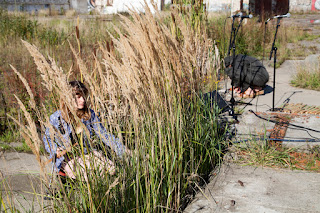Motregen (Drizzle)
Trio Ensemble (live)Motregen will be displayed Until 27 Sept. in the exhibition Manufactum in CC De Ververij, (Sat, Sun, Wed 14-18h, Wolvestraat 37, Ronse.)
On September 26 th it will be placed outside in the metal construction of the old textile factory next to the exhibition space, with a Performance by Trio Ensemble at 16h.
Motregen or Drizzle is the first in a series of Batik-Sculptures. The Javanese batik cloth ‘Udan Liris’ inspires its name. The sculpture is made
from bamboo poles covered with different batik patterns. They can lean against the
beams of a roof structure along a wall or in the space, in parallel diagonal
lines. There are 22 sticks in total, each 5,10m long. The amount of sticks may
differ according to the place and situation.
The sculpture Motregen is made with recycled textiles produced in the factories of the Ronse region during industrial era. Last month The remains of the empty dying factory were used as an open-air studio. Volunteers who wanted to know more about batik and natural dyes could join the batik process and added their own patterns to the sculpture.
The sculpture Motregen is made with recycled textiles produced in the factories of the Ronse region during industrial era. Last month The remains of the empty dying factory were used as an open-air studio. Volunteers who wanted to know more about batik and natural dyes could join the batik process and added their own patterns to the sculpture.
Thank you everyone who joined!!
As a total Udan Liris (Drizzle)
should add to the wellbeing of the one who wears it. The original batik Udan
Liris (drizzle) exists of many diagonal lines of different patterns. Each of
those patterns is a variation on the seven basic patterns used in diagonal
batik compositions called Lereng. The abstracted patterns are derived from
nature such as fruits, flames and the sun, each with their own significance
such as determination, magic power and fertility. The combination of all this
patterns is originally repeated in odd sequences such as 7 or 11 rows,
expressing the words ‘hope’ and ‘mercy’ in old Javanese Language. In practice things
aren’t always like that. Patterns and meanings change constantly according to
the ones who make them and the ones who interpret them.
Thanks to Annegret
Haake to share her knowledge with me.











